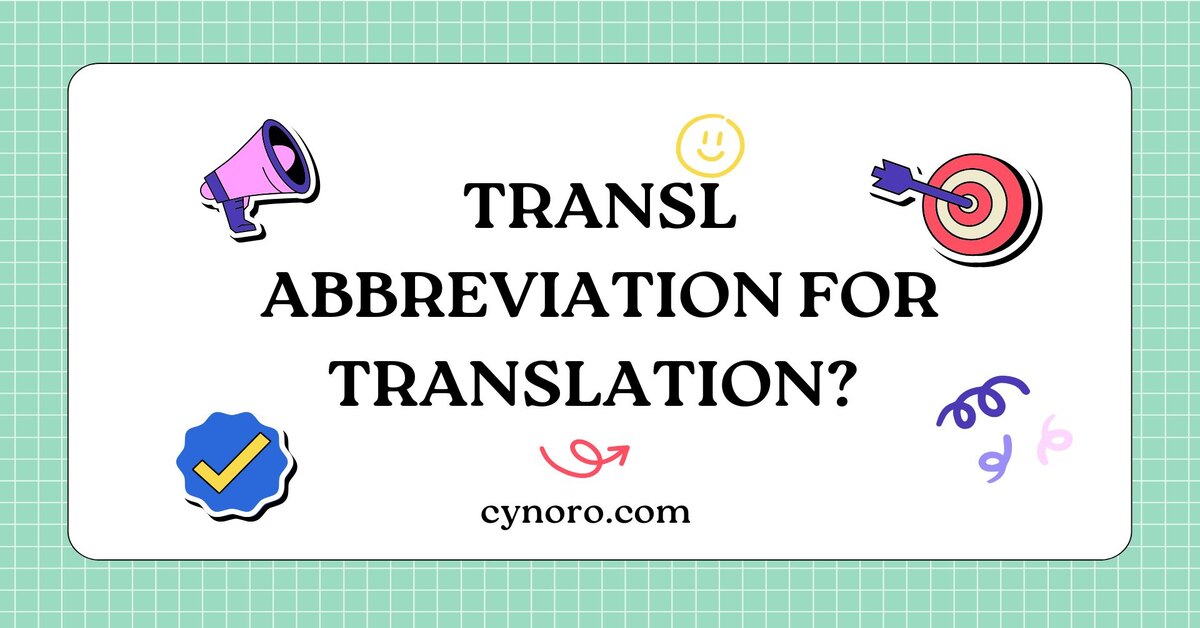The abbreviation for translation might seem like a small detail, but it plays a big role in how we navigate the world of language services. Whether you’re working with documents, apps, or websites, understanding this shorthand can save you time and effort.
You might be surprised by how often the abbreviation for translation pops up in professional and casual settings alike. In this article, we’ll break down what it means, why it matters, and how it can impact your communication across languages. Stick with us—this quick read could make your translation tasks a whole lot easier!
What Is the Abbreviation for Translation?
The abbreviation for “translation” is commonly written as T or T9n. In certain contexts, it can also be written as Trl, but T9n is by far the most widely recognized abbreviation.
Why is this shorthand used? It primarily serves as a space-saving device, especially in the translation industry, where brevity is often essential due to tight deadlines, long documents, or the need for quick communication. It’s a simple way to reference translation without having to spell out the entire word, making it more convenient for professionals.
Here are some key uses of the abbreviation:
- T9n is frequently used in software development, localization, and digital content creation to indicate translation needs.
- T may be employed in informal contexts or by language service providers (LSPs) when discussing translation services.
The Origins and Evolution of the Abbreviation for Translation
The concept of abbreviation dates back to ancient times when shorthand writing systems were developed to facilitate faster writing. In translation, however, the specific abbreviation of “translation” seems to have gained traction with the rise of globalization and digital technology.
Abbreviations like T9n became particularly useful as the need for fast, efficient communication in multilingual content creation grew. Translation professionals working with computer-assisted translation (CAT) tools, for example, embraced such shorthand to streamline project management processes. These abbreviations also took off with the widespread adoption of online platforms, where space is often limited (e.g., in social media posts, software documentation, or translation management systems).
Why Do We Abbreviate “Translation”?
There are several reasons why translation is often abbreviated:
- Efficiency: Time is a critical factor in the translation industry. Using T9n or T reduces the amount of space and effort required to write the full word. This can be especially helpful when working with large volumes of content.
- Clarity: In contexts like localization or machine translation (MT), using T9n helps avoid confusion with other terms that might be associated with translation, such as “transcription” or “interpretation.”
- Convenience: As the digital age progresses, abbreviations have become a go-to for simplifying tasks. Whether it’s in translation software tools, email communication, or documentation, abbreviating “translation” makes it easier to process and organize information.
How to Pronounce “Translation” vs. Its Abbreviations
While the word “translation” is straightforward to pronounce, T9n is typically pronounced as “tee-nine-n” or simply “tee-n.” The abbreviated form T is pronounced as the letter “T.”
However, T9n and T are rarely used in spoken language. They are mostly found in written communication within the translation industry, language services, or tech-related fields.
How to Effectively Use the Abbreviation “T9n”
Knowing when and how to use T9n effectively can help you avoid confusion. Here are some tips:
- Industry Usage: In the translation industry, it’s crucial to understand the context in which abbreviations are acceptable. For example, T9n is often used in translation briefs, project plans, and documents related to software localization or multilingual websites.
- Client Communication: When dealing with clients, it’s best to confirm whether they understand abbreviations like T9n. In some cases, clients might prefer full terms for clarity.
- Project Management: If you’re working on translation projects using a Translation Management System (TMS), using T9n can help speed up communication, especially when tracking source language (S.L.) and target language (T.L.) versions of a document.
- Documenting and Reporting: Whether you’re writing an internal memo or a report on translation progress, using abbreviations like T9n can simplify the document, making it easier for colleagues to understand.
The Role of Translation in the Digital Age
The digital transformation has had a profound impact on the way translation is carried out. Machine Translation (MT), such as Google Translate, has become a valuable tool, though it still requires Machine Translation Post-Editing (MTPE) by human translators to ensure accuracy. The abbreviation T9n has been adopted across various fields like multinational websites, app localization, and content creation to describe the translation processes within these digital environments.
Localization and globalization are two key concepts closely tied to translation in the digital age. Localization refers to adapting content for specific cultures or regions, while globalization involves creating content that can be easily adapted for various markets. As companies expand globally, these processes increasingly rely on translation and abbreviations like T9n to ensure that content reaches the right audience in multiple languages.
When and Where to Use the Abbreviation for Translation
While abbreviations like T9n are incredibly useful, knowing when to use them is just as important. Here are some situations where you might use the abbreviation:
- Tech-Related Content: In software development, websites, and apps, where content is constantly updated and translated, abbreviations like T9n can save time and space.
- Internal Communication: Within translation teams or agencies, using abbreviations like T9n makes internal communication more efficient.
- Project Documentation: For managing large translation projects, T9n can be used in emails, schedules, or spreadsheets to track progress and deliverables.
However, when engaging with clients, always ensure they are familiar with the abbreviation. Some industries, especially those dealing with formal or legal translations, may require the full term for clarity.
The Difference Between Acronyms and Abbreviations in Translation
It’s important to distinguish between acronyms and abbreviations. An abbreviation is a shortened form of a word or phrase, while an acronym is a type of abbreviation that is pronounced as a word.
In the case of T9n, it is an abbreviation, as it is written as a shortened version of the word translation. On the other hand, acronyms like MT (for Machine Translation) or CAT (for Computer-Assisted Translation) are examples of abbreviations that form an acronym because they are pronounced as words.
Understanding this distinction is vital, especially when working in language services or translation management systems, where accuracy and consistency are paramount.
Examples of “T” and “T9n” in Context
Here are a few real-world examples where T9n or T might be used:
- Email Communication: “We are still waiting for the T9n of the latest version of the app for French localization.”
- Translation Brief: “Please ensure that all T9n is completed by the end of the week.”
- Project Management: “The T9n for this document will be reviewed and finalized by the end of the month.”
These examples showcase how the abbreviation is used to quickly communicate translation-related details.
Synonyms and Alternatives to “Translation”
While translation is the most common term, several synonyms exist:
- Interpretation: Refers to the spoken version of translation, often used in real-time settings.
- Paraphrase: A restatement of a text or passage in your own words.
- Rendering: Often used in literary contexts, referring to the translation of artistic works or music.
- Conversion: The process of changing something from one form or medium to another, such as converting text from one language to another.
Each of these terms has subtle differences but can be used interchangeably depending on the context.
Common Misunderstandings About Abbreviations for Translation
Some common misconceptions about the use of abbreviations like T9n include:
- Overuse: While abbreviations are helpful, overusing them can lead to confusion, especially for clients unfamiliar with industry-specific shorthand.
- Inappropriate Context: Using T9n in formal documents or legal translations might be unprofessional. It’s always best to tailor your approach based on your audience and project.
Other Common Abbreviations in the Translation Industry
In the translation world, several other abbreviations are commonly used, including:
- MT: Machine Translation
- MTPE: Machine Translation Post-Editing
- CAT: Computer-Assisted Translation
- TMS: Translation Management System
- LSP: Language Service Provider
Each of these plays a vital role in the translation process, particularly in more technical or large-scale translation projects.
When Not to Use Abbreviations for Translation
While abbreviations are efficient, there are times when using T9n or T is inappropriate:
- Formal Documentation: Legal or highly formal translations often require full, unambiguous wording.
- Client Communication: Not all clients are familiar with abbreviations. It’s best to use full terms unless you’re certain the client understands the shorthand.
Conclusion: Navigating the Use of Abbreviations in Translation
In conclusion, abbreviations like T9n provide translation professionals with a practical and efficient way to handle the demands of modern translation workflows. By understanding when and how to use these shorthand terms, you can improve your communication, save time, and maintain professionalism.
Whether you’re working in software localization, content creation, or multilingual website management, adopting and mastering translation abbreviations can make your projects smoother and more streamlined. Just remember to tailor your use of these abbreviations to your audience and context—doing so will help you navigate the world of translation more effectively.

Tony James is an expert blogger at Cynoro, specializing in the English language. With a passion for teaching and writing, he empowers learners to achieve fluency and confidence.








